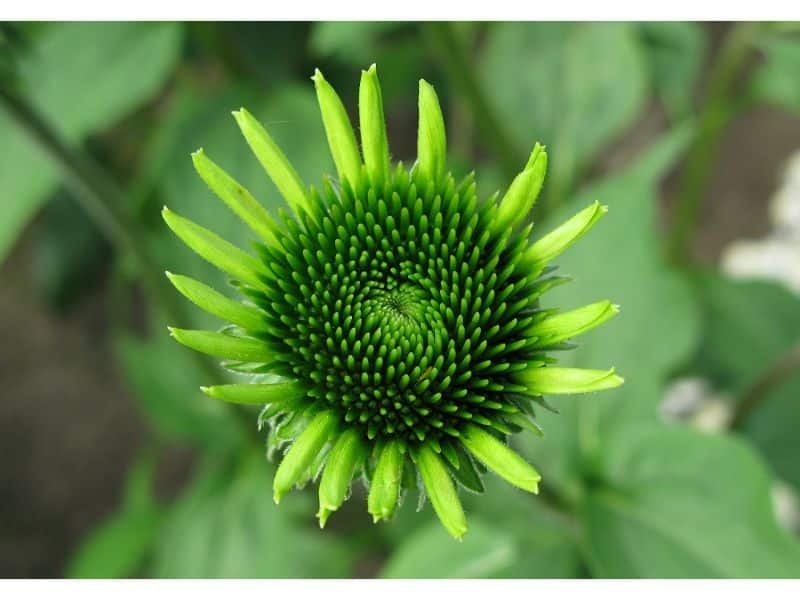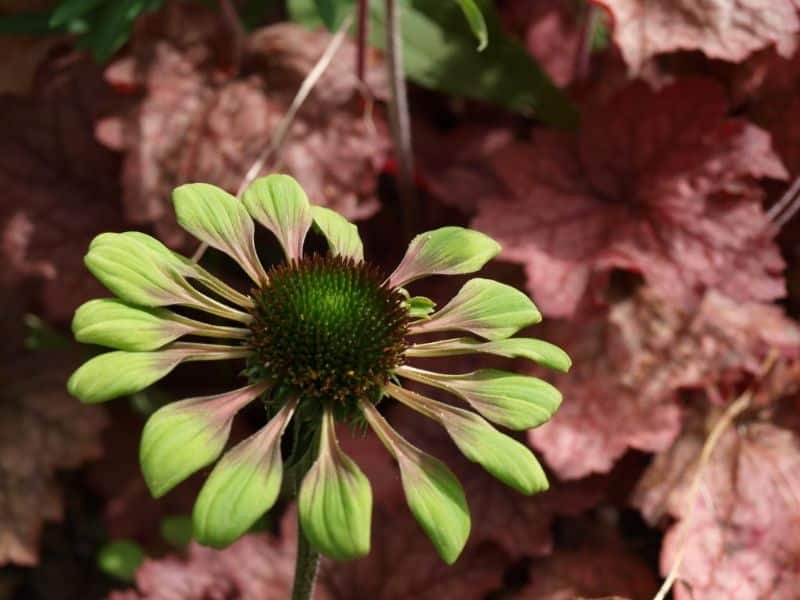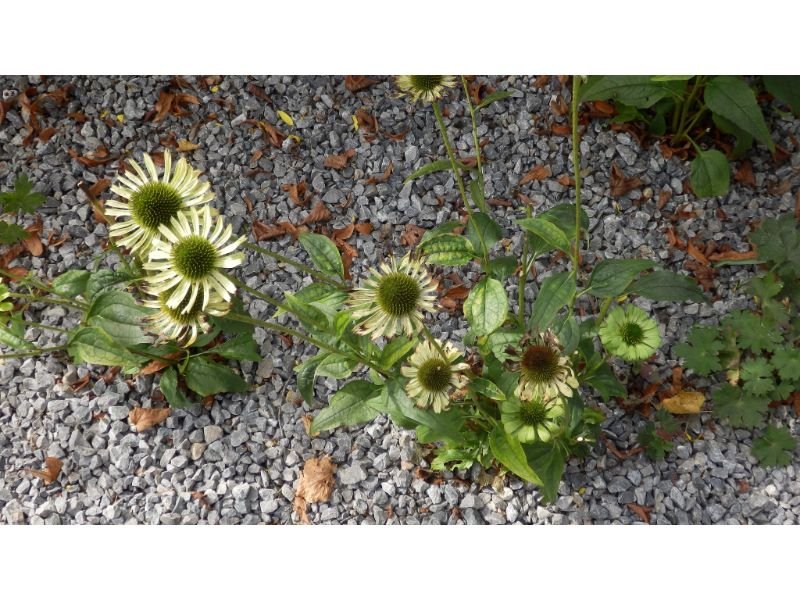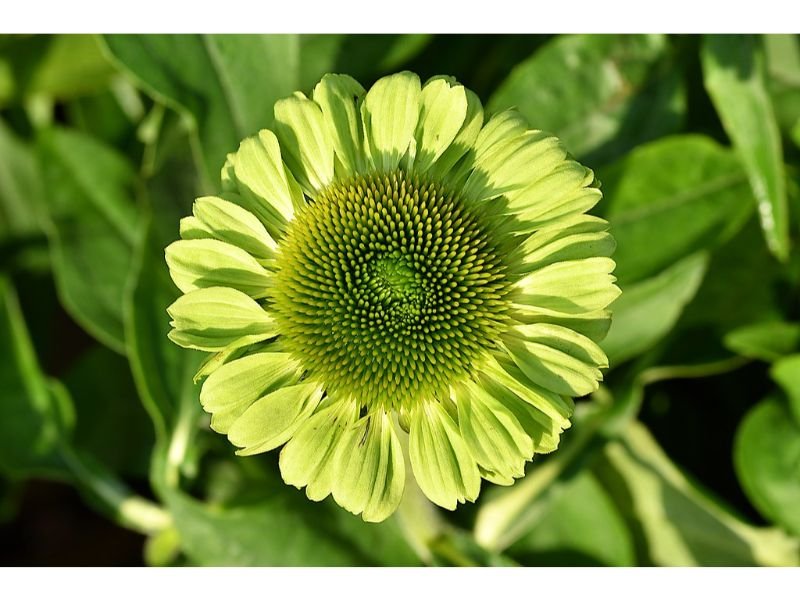Green coneflower varieties are strenuous and less readily available in the commercial market, but their popularity has skyrocketed over the years. More gardeners and plant enthusiasts appreciate their unique and eye-catching appearance, and thankfully, as a result, more and more nurseries carry select green echinacea for intentionally bred or cultivated. If you’re new to this rare botanical gem or have no idea which variety to cultivate, here are our best pick green coneflower varieties to grow.

Table of Contents
Best Green Coneflower Varieties That Are Easy to Grow
Green Envy (Echinacea purpurea ‘Green Envy’)

Planting Zones: 4 to 9
Size: 60 to 90 centimeters high and 48 to 60 centimeters wide
Blooming Time: Midsummer
One of the most standout green coneflower varieties, green envy echinacea maintains the classic daisy-like petal structure with a prominent dark reddish-tan and green center. What’s unique about green envy is that this plant has drooping petals that consist of a gradation in a mint green and bright pink hue. Green envy coneflower has an upright and sturdy growth habit.
Green Jewel (Echinacea purpurea ‘Green Jewel’)

Planting Zones: 4 to 8
Size: 54 to 60 centimeters high and 38 to 45 centimeters wide
Blooming Time: Late spring
Akin to its nickname, this green echinacea reigns as the true treasure of the world of coneflowers with its large and fragrant blooms. Unlike green envy, green jewel coneflower produces flowers with all-green coloration. Its daisy-like petals are in pale green with a hint of white, along with a contrasting sage green-colored center. Thanks to its showy blooms, green jewel coneflower can be used as an excellent cut flower.
Greenline (Echinacea purpurea ‘Greenline’)

Planting Zones: 3 to 8
Size: 50 to 60 centimeters high and 45 to 20 centimeters wide
Blooming Time: Late spring
The good part about choosing green coneflower varieties to grow is that they’re coming in various petal arrangements. So if you’re bored with the classic aster-looking echinacea, this cultivar is probably made for you. Featuring bright pear green, pom-pom-like cones with moss green center and surrounded by drooping and sparse greenish-white petals, greenline echinacea is distinguishable from the previous varieties. This cultivar is a huge fan of regular watering and wouldn’t mind if kept slightly dry.
Green Twister (Echinacea purpurea ‘Green Twister’)

Planting Zones: 3 to 9
Size: 60 to 120 centimeters high and 40 to 60 centimeters wide
Blooming Time: Late summer
Green twister echinacea is often confused with another green coneflower cultivar, and yes, that’s green envy, due to similar coloration. Although they carry indistinguishable hues, green twisters produce petals in an upright formation that sometimes are slightly cup-shaped. This perennial could thrive just fine under direct to partial shade and is generally pest and disease free. Adding green twister echinacea could help attract bees and any other pollinators!
Rare Green Coneflower Varieties
Green Eyes (Echinacea purpurea ‘Green Eyes’)

Planting Zones: 5 to 9
Size: 70 to 110 centimeters high and 60 to 80 centimeters wide
Blooming Time: Late spring
Although this exclusive echinacea cultivar is not completely green, it’s still worth thriving for numerous reasons. First, green eyes echinacea is not the average coneflower that you can find in every nursery, so if you get one, you’re lucky! Next, the unusual coloration of this plant, which is where the nickname came from, consists of elegant aster-like, magenta petals that blend well with the mint green and orange-tan center. Green eyes coneflower was successfully cultivated through special breeding, making this plant a prized rarity among coneflower enthusiasts.
SunSeekers Apple Green (Echinacea purpurea ‘SunSeekers Apple Green’)

Planting Zones: 5 to 9
Size: 45 to 60 centimeters high and 40 to 50 centimeters wide
Blooming Time: Early summer
For all plant lovers with limited growing space, this rare green coneflower is waiting to be planted! Being compact, this perennial is packed with alluring semi-double-layered and ruffled bright matcha green color and yellowish-green centers. Whether you have a balcony, patio, or dull indoor area, this rare, sun and shade-loving green echinacea variety can add a pop of color without taking up excessive room.
Jade (Echinacea purpurea ‘Jade’)

Planting Zones: 3 to 9
Size: 60 to 70 centimeters high and 50 to 60 centimeters wide
Blooming Time: Midsummer
Cultivated in the Netherlands, jade is perhaps the most scarce green cornflower variety that is valued for its single-layered white or white-green petals and prominent jade green or dark mint green center. Depending on light and the plant’s maturity, the corn or centering part of this plant might appear as deep dark green–almost in black hue! Identical to sunseekers’ apple green, jade is a compact-sized green echinacea that is well-suited even for mixed border plantings.
Characteristics of Green Coneflower Varieties
Green Coneflower varieties exhibit several distinctive features that set them apart from other flowers. Let’s explore some of their key characteristics:
- Color: Green Coneflower varieties come in an array of colors, including shades of pink, purple, and white. However, what truly distinguishes them is the green cone-shaped center, from which the name “Green Coneflower” originates.
- Shape: The flowerheads of Green Coneflower varieties are composed of numerous individual florets arranged in a beautiful radial pattern. Each floret has a prominent central disc that resembles a cone, surrounded by delicate petals.
- Height: Depending on the variety, Green Coneflower plants can reach a height of 2 to 4 feet (60 to 120 centimeters). Their tall and slender stems provide an elegant vertical presence in gardens and flowerbeds.
- Blooming Season: Green Coneflower varieties typically bloom from mid-summer to early fall, adorning gardens with their vibrant colors during the warm months.
Cultivation Techniques for Green Coneflower Varieties
Growing Green Coneflower varieties in your garden can be a rewarding experience. To ensure their healthy growth and vibrant blooms, follow these cultivation techniques:
Choosing the Right Location
Green Coneflower thrives in full sun to partial shade. When selecting a location for planting, choose an area that receives at least 6 hours of direct sunlight per day. Ensure the soil is well-drained and fertile, as these flowers prefer moist but not waterlogged conditions.
Planting Green Coneflower
To plant Green Coneflower, follow these steps:
- Prepare the soil by loosening it with a garden fork or tiller. Remove any weeds or debris.
- Dig a hole that is slightly wider and deeper than the root ball of the plant.
- Place the Green Coneflower plant in the hole, ensuring that the crown (where the stem meets the roots) is level with the soil surface.
- Backfill the hole with soil, gently firming it around the plant to eliminate any air pockets.
- Water the newly planted Green Coneflower thoroughly to settle the soil and provide moisture to the roots.
Watering and Fertilizing
Green Coneflower varieties require regular watering, especially during dry spells. Provide them with about 1 inch of water per week, ensuring the soil remains evenly moist. However, be cautious not to overwater, as excessive moisture can lead to root rot.
As for fertilization, Green Coneflower is generally low-maintenance and doesn’t require heavy feeding. Applying a balanced slow-release fertilizer in early spring can provide the necessary nutrients for healthy growth. Avoid over-fertilizing, as it may result in lush foliage but fewer blooms.
Pruning and Deadheading
To encourage prolonged blooming and maintain a tidy appearance, it’s essential to perform regular pruning and deadheading. Deadheading involves removing faded flowers by cutting the stem just above a healthy set of leaves or lateral bud. This practice prevents the plant from expending energy on seed production, allowing it to channel resources into producing more blooms.
Pruning Green Coneflower should be done in early spring before new growth emerges. Trim back the stems to about 6 inches above ground level to stimulate vigorous growth and prevent legginess.
Pests and Diseases
Green Coneflower varieties are relatively resistant to pests and diseases. However, certain issues may arise, including aphids, powdery mildew, and leaf spot. To mitigate these problems, maintain good air circulation around the plants, avoid overhead watering, and promptly remove any infected or damaged foliage.
Are Green Coneflower Varieties More Challenging to Grow Than Other Color Variations?
Thankfully, the growing needs for the mighty green coneflower varieties are generally similar to any other cornflower cultivars with different colors. These beauties are hardy perennials that can live in various growing conditions, from partial shade to full sun. Typically pest and disease-free, green coneflower, like its cousins, is also tolerant to drought once matured and established. They perform well in almost any kind of soil, whether it’s loamy, sandy, or clay, as long as it’s rich in humus and fast-draining, but still restrains moisture well.
Do Green Echinacea Cultivars Attract Pollinators Despite the Unconventional Hue?
Having showy blooms with numerous shades of green is not a guarantee that green echinacea cultivars will attract all kinds of pollinators. Despite having the potential to attract these tiny beneficial animals, pollinators such as bees and butterflies are generally not attracted to green flowers, but moths, flies, beetles, and bats do. Bees and butterflies are more devoted to purple, yellow, red, pink, orange, or blue-colored blooms rather than green.
Can Green Coneflower Varieties Be Used in Floral Arrangements and Bouquets?
Absolutely! Green coneflower varieties with pom-pom blooms like greenline, or cultivars with large and showy blooms such as green envy and green jewel are perfect for incorporating into floral arrangements and bouquets. The theme is up to your taste. You can create a monochromatic bouquet using all green echinacea flowers, or create a floral arrangement heaven by adding more popping colors like red and pink from roses and buttercups, lavender or blue from larkspur and sage, white from baby’s breath or peace lilies, so on.
Why the Extraordinary Green Coneflower Cultivars Are Worth Blooming
Unlike white, yellow, and purple, green coneflower varieties are mainly considered rare, due to the complex and time-consuming breeding process and the green color itself–which is often associated with foliage and stems rather than blooms. Nonetheless, these exquisite floral marvels are worth nurturing as they will present you with stress-free maintenance and eye-catching green blooms that attract small pollinators like moths and beetles.
Can Green Coneflower varieties tolerate drought?
Green Coneflower is relatively drought-tolerant, but consistent watering during dry periods is recommended for optimal growth and blooming.
Are Green Coneflower varieties deer-resistant?
Yes, many Green Coneflower varieties have natural compounds that make them unappealing to deer and other browsing animals.
How long do Green Coneflower blooms last?
The blooming period for Green Coneflower varieties typically lasts several weeks to a couple of months, depending on the specific cultivar and environmental conditions.
Can I grow Green Coneflower in containers?
Yes, certain compact varieties of Green Coneflower, such as ‘Green Jewel,’ thrive in containers and add a burst of color to patios, balconies, or small gardens.
Do Green Coneflower varieties attract pollinators?
Absolutely! Green Coneflower varieties are highly attractive to pollinators like bees, butterflies, and hummingbirds. Planting them in your garden can create a vibrant and buzzing ecosystem.
Can I propagate Green Coneflower from seeds?
Yes, Green Coneflower can be propagated from seeds. Collect the ripe seeds in late summer or early fall, sow them in well-draining soil, and keep them moist until germination occurs.

New author in the hood. Loves gardening and flowers are my spirit animals (yes I know they are not animals but I insist). I will be covering most of the flowers’ topics here and occasionally random though as well.






